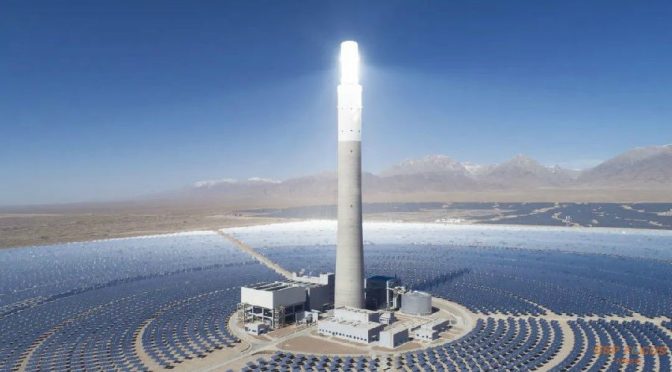Following strong early performance, Supcon Solar is implementing cloud impact measures at the 50 MW Delingha Concentrated Solar Power tower to further increase output.
In March, China’s Supcon Solar said it had exceeded six-month output targets at its 50 MW Delingha Concentrating Solar Power tower plant in Qinghai Province and recorded average output «fulfilment rates» above 100% since January.

Supcon Solar is building systems to reduce cloud risks at the high-altitude Delingha solar thermal plant.
One of the first large-scale tower projects in China, Delingha includes seven hours of thermal energy storage (TES) and is located at an altitude of 3,017 meters, next to a Supcon 10 MW pilot project.
Supcon developed the 50 MW plant and supplied the main technology and engineering procurement construction (EPC) services. Despite harsh weather conditions, the plant was built in a record time of 18 months. The plant reached full load in April 2019 and started commercial operations in September.
Supcon is now combining equipment learnings with the latest cutting-edge AI technology to reduce weather risks and further improve performance, Jin Jianxiang, Supcon Chairman, told New Energy Update.
Supcon believes it can achieve an average fulfilment rate at Delingha above 100% for the first year, Jianxiang said, far greater than the typical rates of 70 to 80% set out in global EPC contracts.
These gains bode well for the 50 MW Minos Concentrating Solar Power tower project in Greece, in which Supcon will supply technology and EPC services.
Weather protection
Due to its location, the Delingha plant must withstand huge temperature variations, sandstorms and frequent cloud coverage.
Clouds stopped operations for 24 days in the first six months of commercial operations while there were no shutdowns due to equipment failure, Supcon said.
Delingha CSP output, fulfilment rates in first six months

Source: Supcon Solar
Supcon used learnings from its pilot plant, online since 2013, to select and optimize equipment.
“We reinforced weather resistance of the heliostat through customized material selection, structuring, and manufacturing techniques,” Jianxiang said.
To tackle temperature and flux density variations, the team reinforced the receiver’s structural resilience to improve efficiency and extend service life.
Supcon also used a unique foundation structure for the molten salt tanks, Jianxiang said.
“We used a ceramic-based composite…which increases bearing capacity and reduces thermal loss,” he said.
Some 95% of the plant equipment is sourced from China which helps to reduce capital costs and maintenance times.
«After-sale service will have a decisive impact on performance,” Jianxiang said. “Domestic suppliers can solve product issues within one week, whereas foreign suppliers need two, even four weeks to deliver the service.”
Data power
Supcon has also integrated the latest automated technology at Delingha to improve performance.
The heliostat field is fully-automated, using machine vision technology and advanced algorithms to detect heliostat deviation and feed auto-calibration systems. Misalignment of heliostats can severely impact performance and becomes more significant for larger CSP plants due to the greater distances between heliostat and CSP tower.
The Delingha plant also uses machine learning to respond to different weather conditions. The system crunches growing historical data to select optimal operation modes.
In addition, an automated vehicle is used to clean the heliostats, boosting efficiency and reducing cleaning costs.
Cloud learnings
Cloud coverage remains a key operational risk for Delingha, as shown in the early outages.
The plant can provide stable electricity during a short cloudy period, but «sudden and unexpected» clouds can impact operation and lead to system shut-down, Jianxiang said.
Cloud systems impose thermal shocks and heat fatigue on the receiver, raising safety issues and shortening the component life, he said.
Advances in cloud camera systems will boost solar thermal plant efficiency in the coming years, researchers say.
Supcon is now using image processing and meteorological data at Delingha, to predict cloud movement and measure the impact on the plant. This data will allow Supcon to adjust the solar field to ensure even distribution of solar energy on the receiver surface and avoid molten salt flow issues, or if a shutdown is necessary, minimize downtime.
“In the upcoming six months, we will be committed to operation optimizations, particularly in the solution of clouds,» Jianxiang said.
As a result, the fulfilment rate is expected to rise «significantly,» he said.

